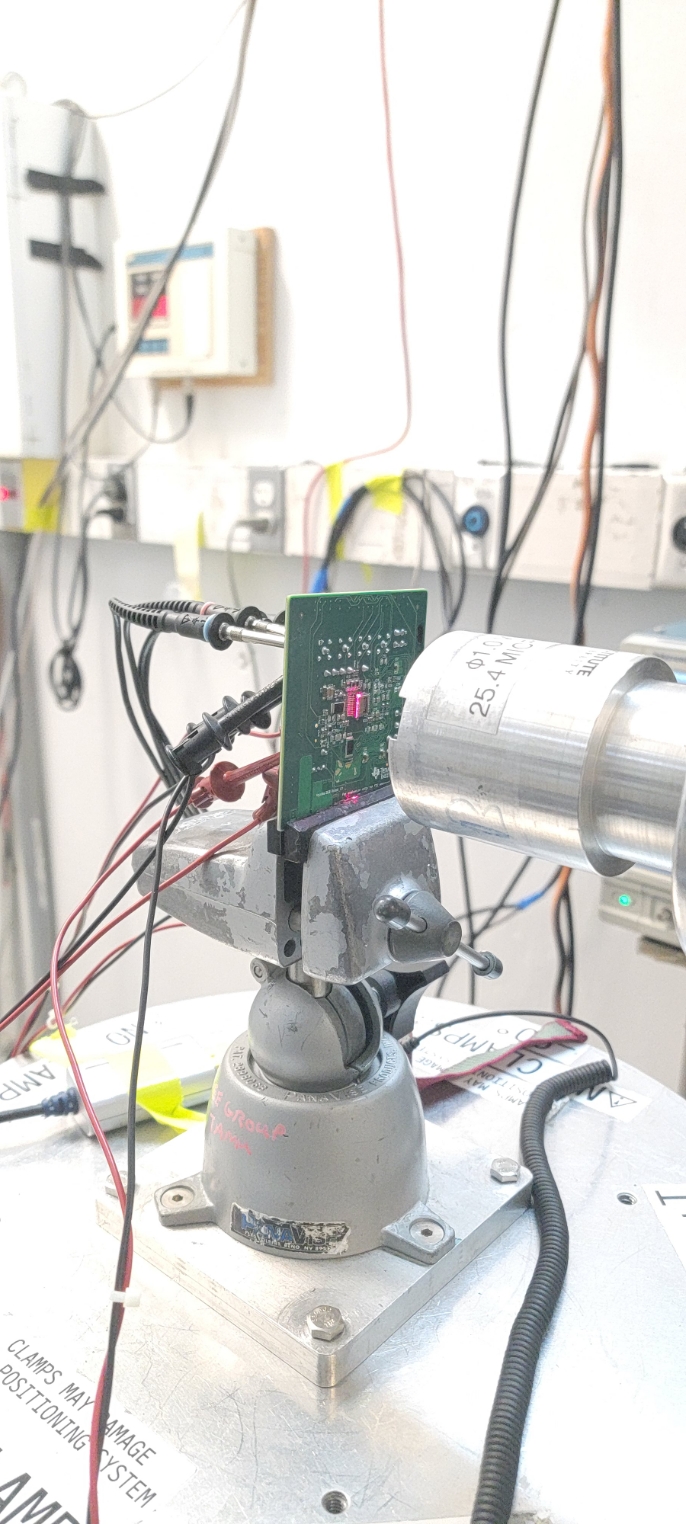SLVK099B March 2022 – September 2023 TPS7H5001-SP , TPS7H5002-SP , TPS7H5003-SP , TPS7H5004-SP
PRODUCTION DATA
- 1
- Abstract
- Trademarks
- 1 Introduction
- 2 Single-Event Effects (SEE)
- 3 Device and Test Board Information
- 4 Irradiation Facility and Setup
- 5 Depth, Range, and LETEFF Calculation
- 6 Test Setup and Procedures
- 7 Destructive Single-Event Effects (DSEE)
- 8 Single-Event Transients (SET)
- 9 Event Rate Calculations
- 10Summary
- A Total Ionizing Dose from SEE Experiments
- B References
- C Revision History
4 Irradiation Facility and Setup
The heavy-ion species used for the SEE studies on this product were provided and delivered by the TAMU Cyclotron Radiation Effects Facility using a superconducting cyclotron and an advanced electron cyclotron resonance (ECR) ion source. At the fluxes used, ion beams had good flux stability and high irradiation uniformity over a 1-in diameter circular cross-sectional area for the in-air station. Uniformity is achieved by magnetic defocusing. The flux of the beam is regulated over a broad range spanning several orders of magnitude. For these studies, ion flux of 7.26 × 104 to 1.65 × 105 ions/cm2·s was used to provide heavy-ion fluence of 9.96 × 106 to 1.01 × 107 ions/cm2.
For the experiments conducted on this report, there were 4 ions used: Krypton (Kr), Silver (Ag), Praseodymium (Pr), and Holmium (Ho). Kr was used to obtain LETEFF of 30.5, 37.3, and 40.6 MeV·cm2/mg. Ag was used to obtain LETEFF of 47.8 MeV·cm2/mg. Pr was used to obtain LETEFF of 65 and 75 MeV·cm2/mg. Lastly, Ho was used to obtain LETEFF of 75 MeV·cm2/mg. The total kinetic energy for each of the ions are shown in Table 4-1.
| Ion Used | Ion Uniformity Range |
|---|---|
| 84Kr = 2.081 GeV (15 MeV/nucleon) |
94% to 95% |
| 109Ag = 1.634 GeV (15 MeV/nucleon) |
95% to 97% |
| 141Pr = 2.114 GeV (15 MeV/nucleon) |
90% to 96% |
| 165Ho = 2.47 GeV (15 MeV/nucleon) |
91% to 95% |
Figure 4-1 shows the TPS7H500x-SP SEE Test Board used for the data collection at the TAMU facility. Although not visible in this photo, the beam port has a 1-mil Aramica window to allow in-air testing while maintaining the vacuum within the accelerator with only minor ion energy loss. The in-air gap between the device and the ion beam port window was maintained at 40 mm for all runs.
 Figure 4-1 Photograph of the TPS7H500x-SP
SEE Test Board in Front of the Heavy-Ion Beam Exit Port at the Texas A&M
Cyclotron
Figure 4-1 Photograph of the TPS7H500x-SP
SEE Test Board in Front of the Heavy-Ion Beam Exit Port at the Texas A&M
Cyclotron